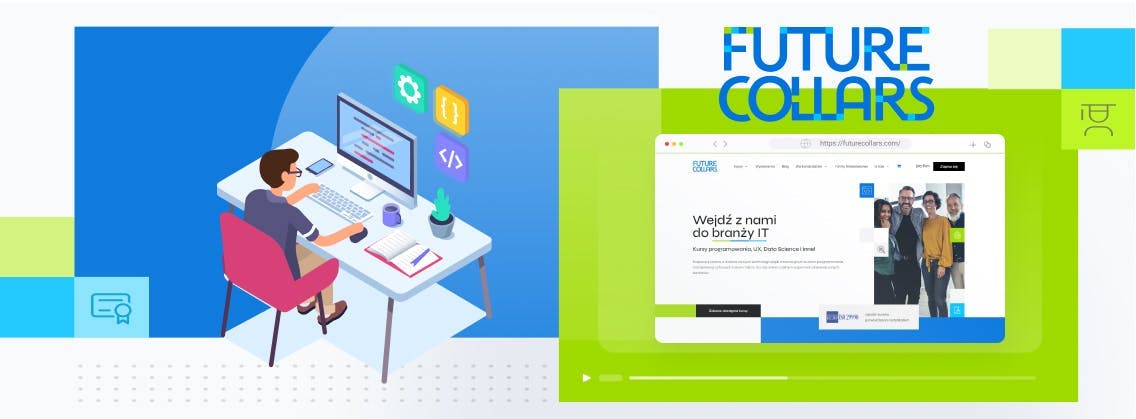- Developer
- Business role
- CTO/IT Director
- CEO/Founder
- Product Owner
- Other
EduTech
What is Education Technology?
Education technology, also known as EdTech, refers to the use of digital tools and platforms in education. It includes everything from online learning tools to software teachers use in the classroom.
EdTech has become increasingly popular as schools and districts have shifted to a more digital-based curriculum. The EdTech industry is a rapidly growing field that focuses on the use of technology in education.
One of the main benefits of EdTech is that it can help students learn in a variety of ways. For example, online learning tools can provide students with a more individualized learning experience, while digital textbooks can help improve reading comprehension and engagement.
Additionally, EdTech can also help educators save time and improve their teaching practices.
What does the EdTech industry look like?
The EdTech industry can be divided into several segments, which are:
- Hardware: This segment includes companies that produce devices such as tablets and laptops.
- Software: This segment includes companies that produce software such as learning management systems and assessment tools.
- Service Providers: This segment includes companies that provide services such as cloud storage and online tutoring.
- Distributors: This segment includes companies that distribute EdTech products and services, such as through schools or retail stores.
The potential for EdTech is huge, and it is rapidly growing. Learning is no longer confined to the traditional classroom, and with the right tools, students can learn anywhere at any time.
The current state of the EdTech
EdTech is currently booming, especially with the rise of online and digital learning tools. A coronavirus pandemic has significantly impacted EdTech and e-learning.
Schools have been forced to close, and many parents have been homeschooling their children. This has led to a surge in demand for EdTech products and services that enables students to continue learning remotely.
The education sector has gained traction due to investments made by innovators and governments. The EdTech market was valued at USD 89.49 billion in 2020 and is expected to grow at a CAGR of 19.9% from 2022 to 2028.
EdTech products and services are evolving in line with the latest technologies, such as augmented reality (AR), virtual reality (VR), and the internet of things (IoT). This is helping to drive demand for EdTech products and services.
Other driving factors behind the EdTech boom include the increasing use of technology in schools and the growing emphasis on STEM education. As schools all over the world adopt more technology in the classroom, the EdTech market is expected to continue growing at a rapid pace.
Build with us your EduTech product!
What are EdTech challenges?
The EdTech industry is constantly evolving, with new tools and platforms being developed to support digital learning. However, there are some challenges that EdTech companies face in terms of meeting the needs of educators and students.
Here are some of the key EdTech challenges:
1. Inclusive Education
Inclusive education is one of the key EdTech challenges, as it requires schools and educators to provide equal access to education for all students. This can be a challenge due to the range of needs that students have, as well as the various ways that technology can be used to support learning.
2. Personalized Learning
Another key EdTech challenge is providing personalized learning for students. This requires EdTech companies to develop tools that can be tailored to the individual needs of each student. This is a challenge due to the diversity of students and their needs, as well as the rate at which technology changes and evolves.
3. Skills Development
To keep up with the changing landscape of education, EdTech companies need to make sure students are learning the essential skills that they need for the future, including critical thinking, creativity, collaboration, and communication. These are known as soft skills, and they are becoming increasingly important in the workplace.
4. Lower User Engagement:
One of the challenges for EdTech companies is that users can often be less engaged with their products than they would like. This can be due to a number of factors, including the complexity of the tools, the lack of relevance to students’ needs, or the design of the platform.
Education technology trends
While technology has always been a part of education, it’s only been in recent years that its use has exploded. From online learning to digital textbooks, technology is changing the way students learn.
Here are ten of the most important EdTech trends to watch in 2022 and the coming years:
1. Virtual Reality & Augmented Reality. VR and AR technologies allow students to learn in a completely immersive environment, which can be very effective for teaching certain subjects. For example, VR can be used to teach soft skills like teamwork and communication (ex. consumer service), while AR can be used to teach science and math concepts in a more hands-on way (ex. medical service). The results will be students who are more engaged and better able to learn.
2. E-learning. E-learning has been an education technology trend for many years now. It has allowed students to learn in ways that traditional learning cannot provide. In addition, e-learning allows students to have more control over their own learning and provides a more personalized experience. E-learning platforms such as Udacity, Guild Education, Coursera, and Masterclass offer a wide range of courses in various fields of study.
3. Online Distance Learning. In recent years, the use of online distance learning has increased as a method of education. This is in part due to the fact that during times of crisis, such as pandemics, more people tend to turn to this form of education. The benefits of online distance learning include increased flexibility, increased affordability, and easier access to resources, while also allowing for social interaction.
4. AI-Enabled Adaptive Learning. AI-enabled adaptive learning is one of the most important education technology trends in 2022. AI-enabled adaptive learning allows students to learn in a way that is customized specifically for them. This type of learning uses artificial intelligence to monitor students' progress and then adapts the lessons accordingly, which in the end leads to higher learning efficiency. This ensures that each student is always learning at their own pace and that they are constantly challenged.
5. Gamification. This trend uses games to make learning more fun and engaging for students. Gamification involves using elements of games in learning, such as points, rewards, and levels. This encourages intrinsic motivation in students, as they are working to achieve goals and rewards. If students are more engaged in the material, they are likely to have a better educational experience.
6. Mobile Learning. Mobile learning uses mobile devices, such as smartphones and tablets, to deliver educational content. Mobile learning allows students to learn anywhere and at any time. In addition, it provides a more personalized experience, as students can access content that is specific to their needs. There are many different mobile learning applications, such as Duolingo, Quizlet, DailyArt, Curiosity, and Khan Academy.
7. Smart Speakers. Smart speakers, such as the Amazon Echo and the Google Home, are devices that use artificial intelligence to answer questions and control other devices. In 2022, it is predicted that smart speakers will be used in education to improve student learning. For example, teachers could use smart speakers to provide students with educational content, pronunciation drills, and test reviews. Additionally, smart speakers can be used to help students with homework. By asking questions about specific topics, smart speakers can provide students with answers quickly and easily.
8. Learning Management Systems (LMS). A learning management system (LMS) is a software application that helps educators create, deliver, and track online courses. An LMS allows teachers to manage all aspects of their courses, including materials, quizzes, and assignments. In addition, it provides students with a way to track their progress and achievements. LMSs are popular in education because they provide a one-stop shop for educators to manage their courses.
9. Video Conferencing and Communication Tools. Video conferencing and communication tools allow educators to communicate with each other and with students. They provide a way for educators to share ideas, materials, and assessments. In addition, they allow students to connect with each other and with their teachers. There are many different video conferencing and communication tools available, such as Zoom, Skype, Google Hangouts, Remind, and Edmodo. All of these tools have different features that make them useful for educators.
10. Tools for Creating Educational Content. One of the most recent trends in EdTech is the use of tools to create educational content. Tools like Newsela, Instructure, Kahoot!, Loom, and Canva allow people to create courses, tutorials, upskilling videos, and mentoring videos. This trend is beneficial because it makes learning more accessible and attractive visually. Such tools make it easy for educators to produce quality educational content and adjust it to the way that works best for their students.
Technologies we use at LeanCode
How to increase an Education technology product's success rate?
When it comes to designing EdTech tools, there are several key factors that you should emphasize on. These factors include efficacy, intrinsic motivation, student experience, teacher experience, and Zone of Proximal Development.
By keeping these factors in mind, you can help ensure the success of your EdTech tools.
- Efficacy: Efficacy is the ability of a tool to produce the desired outcome. When designing EdTech tools, it is vital to ensure that they are effective in helping students learn. The often desired features by students are earning points, watching entertaining videos, or raising a state test score.
- Intrinsic motivation: Intrinsic motivation is the desire to do something for its own sake. When designing EdTech tools, it is important to focus on intrinsic motivation factors, such as challenge, curiosity, and control. Many ed-tech tools rely on features like points, badges, and even competition among peers to motivate students to stay engaged extrinsically.
- Student experience: Student experience is essential when designing EdTech tools. It is necessary to consider what aspects of the learning process are most engaging for students. In addition, it matters to make sure that EdTech tools are easy to use and navigate. Research if your tool will meet their varying needs, and if so, what protocols, modifications, or settings you will need to put in place.
- Zone of Proximal Development: The Zone of Proximal Development is the optimal learning space where a student engages with tasks beyond what they have the skill to accomplish alone, but they can learn with assistance. When designing EdTech tools, it is worth including software solutions like the “knowledgeable guide,” such as an audio recording of a more challenging text.
- Teacher experience: Teachers have a deep understanding of their students’ struggles to gain knowledge. They are also aware that school lags behind as each generation lives more and more in the online world. They are the best group to develop tools with since they know the limitations of stationary education based on old-fashioned forms of learning repeated over the years.
Our Projects
How to capture value from EdTech?
EduTech is a market aimed not only at teachers and students but also at employees of smaller and larger companies from various industries. When it comes to capturing value from EduTech, there are a few key things to keep in mind.
1. Understand the EdTech market. It's essential to know the EdTech market and understand the trends within it. Assess the strengths and weaknesses of your competitors. Developing a unique value proposition that stands out from the competition is crucial.
2. Narrow down your product niche.Once you've done that, you need to narrow down your niche and focus on a specific area of EdTech that you can dominate. According to CBS Insights, 42% of startups fail because they don't address a real need. This will help you develop a proof of concept or MVP that can be used to demonstrate the feasibility of your idea.
3. Propose a unique value proposition.Each year the competition in EdTech increases, so it's crucial to know what's important to your target audience. It might be pricing, performance, functionality, design, integrations, or support. Knowing what's different about your product will help you craft effective messaging.
4. Choose a sustainable business model.The right business model will allow you to generate a profit over the long term. EdTech is a rapidly growing industry, so there's plenty of potential for success if you can capture value in the right way. There are several to choose from, like Freemium subscription, Free trial subscription, B2B sales, and more, and each has benefits and downsides.
5. Work with the experienced development team. The secret to a successful EdTech product is having a well-rounded team of professionals who understands both technical aspects and aspects that refer to users' needs. Such a team will also deliver additional value through their experience and insights from earlier built products.
At LeanCode, we have built digital products for the education sector - one of them is Future Collars, an e-learning platform that targets people who want to acquire IT skills.




